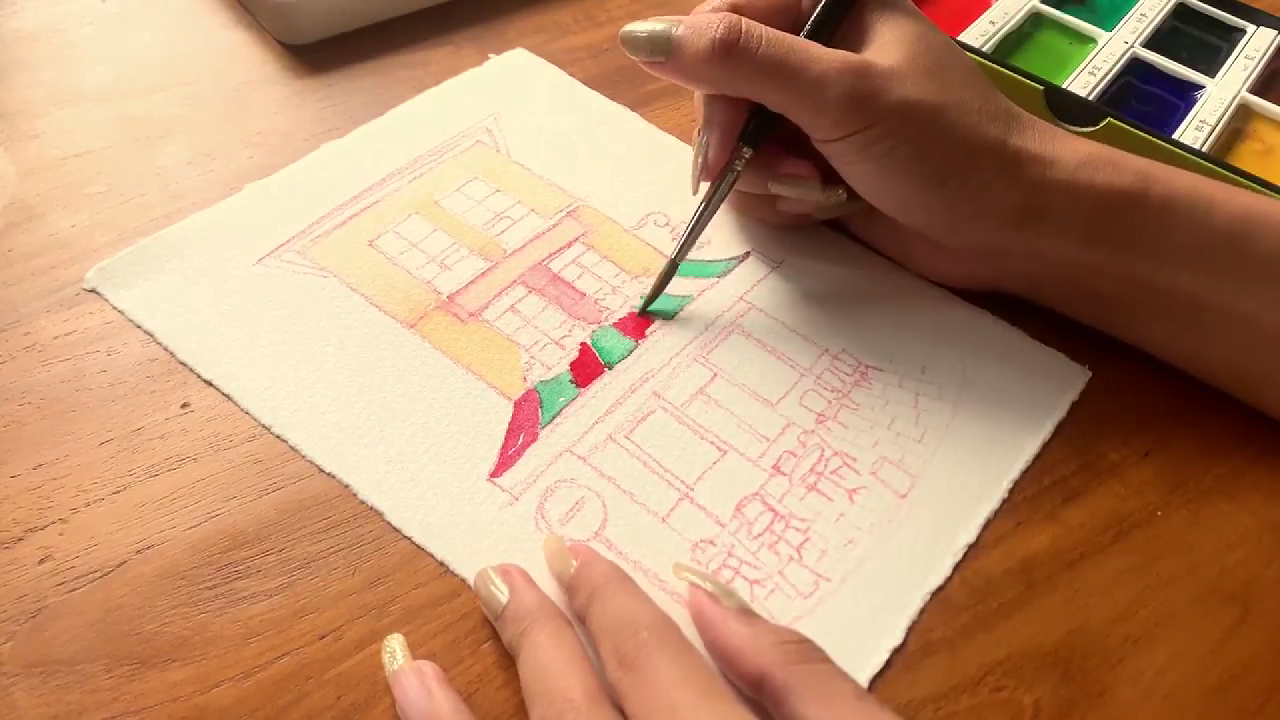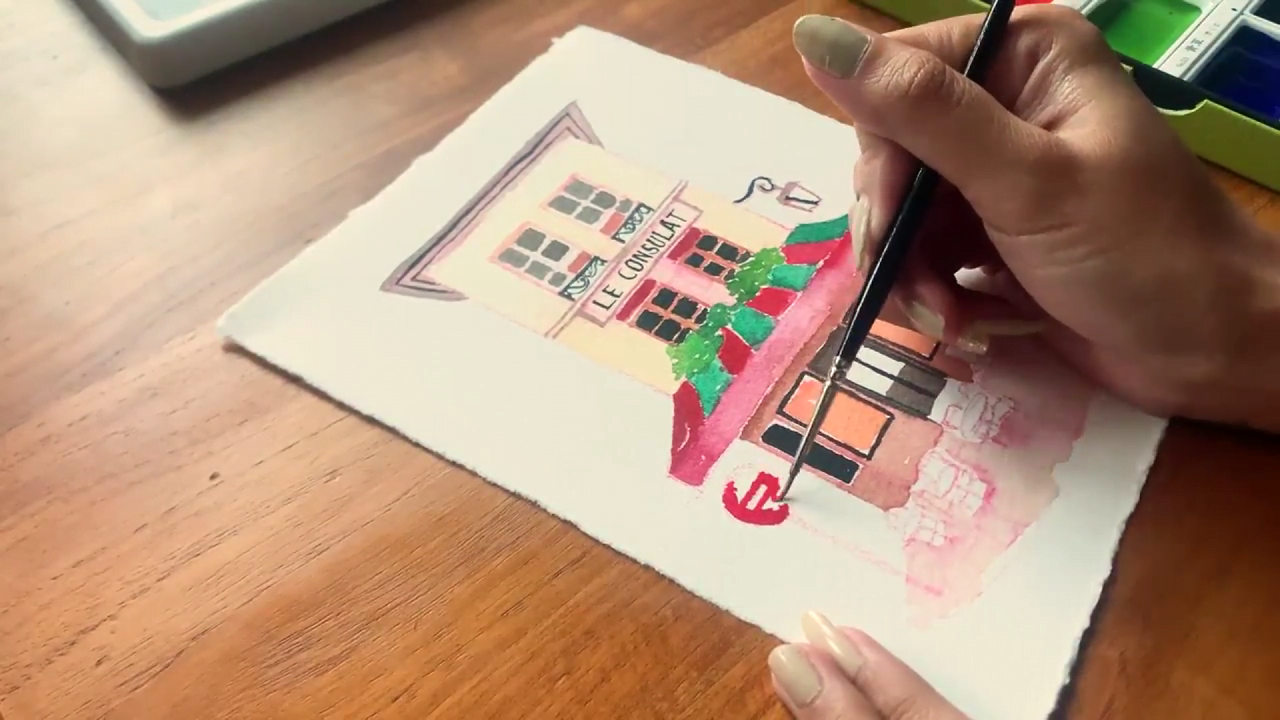Paris is a city renowned for its beauty and charm, and one of the most iconic landmarks that capture its essence is Le Consulat café.

The quaint establishment, located in the charming neighborhood of Montmartre, has been popular among artists, writers, and intellectuals for over a century. Want to grab breakfast with friends? Head over to Le Consulat. Looking for a subject for your next art project? Grab a seat outside the café and recreate the Parisian gem on paper!
It’s adorned with vibrant red and green hues, the color combo that screams “Pa-ree!” As such, capturing the beauty of Le Consulat in watercolor will surely be a rewarding process, even for beginners. With the right materials and techniques, you can create a stunning painting that pays homage to this iconic café and the city of Paris itself.
So, without further ado, let’s get started…
Painting Paris Le Consulat In Watercolor
The right tools can make all the difference when it comes to creating a successful work of art. So, I suggest using a comfortable paintbrush that offers durability and versatility. You should also consider investing in good-quality watercolor paints that offer a consistent texture and high pigmentation, you can read more about the types of watercolor paints here.
That said, here’s what I’ll be using for painting the legendary café:
Paint: Kuretake Gansai Tambi Watercolors 12 color | Paper: Saunders Waterford Watercolor Paper - White, 300gsm | Brush: Raphael Kolinsky Sable Fine Point Round Brush 8404
Step 1 - Creating A Light But Detailed Outline

First off, sketch a basic outline of the Le Consulat building on your paper. Although I’m using watercolor paper, you can use your sketchbook or just any paper that’s thick enough to hold watercolors.
As for the pencil, I’m sticking to my “holy grail” - a light-colored pencil! The soft tip of colored pencils helps me create a light sketch, visible enough to act as a guide while I paint. On the contrary, if you use a regular pencil, you may end up with harsh lines, which may be difficult to hide beneath sheer watercolors.

Slowly, I’ll add some details while sketching. I don’t do this often and simply draw a rough sketch. However, considering the various intricate elements of this café, I think it’s best to create a detailed sketch to avoid mistakes while painting.
After all, you wouldn’t want to mess up painting Vincent Van Gogh’s favorite café!
Step 2 - Painting The First Layer

Next, use just a tad bit of yellow mixed with a lot of water for the first layer. Remember to keep it very light and add more color gradually - not all at once.
I’ll use the same consistency for the second and third floors of the café. I recommend leaving out the windows and other details right now and focusing on the walls only.
Step 3 - Painting The Canopy

Perhaps the most iconic part of Le Consulat is its canopy. The vibrant red and green combination makes the tiny café visible from miles away, allowing everyone to flock to its door every morning! I especially like how this bright canopy creates a striking contrast against the neutral color scheme of this house-turned-café.

Once the canopy is painted using vibrant shades of red and green, paint the first layer of the ground floor. Here, I’ll use brown, while keeping it as light as possible.
Step 4 - Adding Details

Once the first layer is dry, proceed to add some details, like windows, plants on the balcony, cracks on the walls, the name board, etc.
Note that I’m only painting according to my memory from the last time I visited Paris and the pictures I managed to click amidst the crowd. But if you’ve been lucky to drop by the café recently, feel free to add new details to the building.
Step 5 - Painting The Second Layer

After painting the windows and doors, you can add a second flush of color to the painting. I’ll start with the canopy, as that should be the focal point of the scene. Notice how I’m gradually adding a thicker consistency of paint on each part of the canopy. As I’m adding more reds and greens, the café is slowly coming to life - I can already sniff the freshly prepared crepes!
Let the painting dry completely before making any final touches.
Step 6 - Adding More Details

Finally, I’ll add more details and sharpness to the artwork by painting the outlines of the door and windows. Use a small brush, just as I am, to make precise strokes. While I may not remember the intricacies of Parisian architecture very well, simply outlining basic structures can make a world of difference.
I’ll further paint the cute little chairs outside the café, which are usually occupied throughout the day. But that didn’t stop me from grabbing a treat whenever I craved something sweet!
And just like that, with a few more details, my rendition of the cozy café at the heart of Montmartre is ready. What do you think?

Besides painting on watercolor paper to be framed and propped up on your wall, I suggest turning it into a postcard and sending it to a friend. Or, you could make a birthday card with this warm and inviting painting of Le Consulat in the front and gift it to someone who loves Paris!
For a more personalized touch, consider writing a message explaining why you chose the painting or what it means to you. Regardless, I guarantee any art enthusiast or travel junkie will appreciate such a thoughtful gift.
Other than that, you can experiment with the composition - maybe paint the sky or add more trees surrounding the café. Your imagination is the limit!
So, take your time and experiment with different colors and techniques to create your unique masterpiece.

To Sum Up
Watercolor is a unique medium that allows seamless blending for stunning effects on paper. And with an iconic subject like Le Consulat, you can express your creativity in capturing the beautiful heritage of Paris.
With this step-by-step guide, I’m sure you’ll be able to create a painting that showcases your artistic skills. And if you’re a beginner, I hope this article inspires you to try your hand at watercolor painting and explore your creative side.
Just remember to take your time and enjoy the relaxing and rewarding process, and if you enjoy this one do cast a glance over our next tutorials on How to Paint Berlin with Watercolor and How to Paint Trees with Watercolor, they're both beginner-friendly watercolor tutorials that you'll surely enjoy!
Happy painting!
